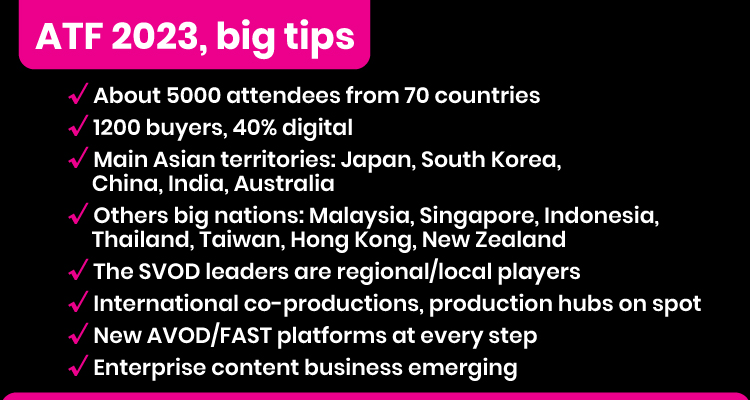After the recent markets that took place in the content calendar —Mipcom, MIPcancun, Content London— the industry evolves with mostly good sensations: the content market is not as before the pandemic, but is healthy and growing, pushed mainly by three trends: the progressive return of major distribution to third parties, the international co-production models and the AVOD & FAST fever. On the three, Asia and APAC in particular, are leading regions. So, we can expect for Singapore very good traffic and many emerging opportunities.

At Mipcom, one of the main conclusions was that Asia has been back, after the long break of the pandemic. China was the top attending country at the convention, but Japan and Korea have been strong engines, as soon as India, Hong Kong, Taiwan, Malaysia, Singapore, Thailand, Indonesia, were other good sources of fresh business. Middle East, on the other hand, was the region with top buyer growth, including cross-regional productions in Arabic language as a current big trend.
And we must talk especially about Australia. Today is one of the top players in co-production ventures with the US big studios and European titans, as in the past was just Japan. During last May LA Screenings, in Los Angeles, from ten new series presented by the US major studios, 3-4 had Australian partners, apart from UK or German ones. Awesome.
Market tips & trends during those events? The reduction of SVOD projects continues all around the world, reinforcing the position of broadcasters as more stable partners for the big studios. Though, some sights of demand recovery are seen in Netflix and Apple, especially in Europe and the US market. Others as Disney, are waiting for their staff restructure to end. In Asia, where the leading SVOD are regional/local players, the segment has less ups & downs.
Through all the world, most of broadcasters are worried about rising costs vs. hard advertising incomes. Even, many have sensible employee reductions. With digital, fragmentation is inevitable. Though, some European free TV players are facing growing ad numbers, and they are buying more product due to that. In Asia, the broadcasters are experimenting big changes, adequation processes too, but mainly for digitalization, to turn to strong digital groups.
About genres, big prime time entertainment takes most of the attention of broadcasters worldwide. As many consider there are no fresh formats, some players as Fox USA, are betting on paper formats to create properties that then can sell to the world. Fox is making alliances with TF1 France, Atresmedia Spain, and good investments to make these projects real. Against producers, they keep all the rights.

About fictions, according to The Wit’s Fresh TV, True Crime, real-stories based series and fantasy/Science Fiction, are the main recent preferred options. In scripted production, Spain continues as the powerhouse of the moment. It sells formats, it exports directors, actors and writers. Soon, Spanish studios will produce in UK or USA for the international market, with USD 4 million budget per episode. About Asia, Japan and South Korea are on the same way, but more focused on co-productions than productions on demand.
New digital streaks? Within the next two years, all the main broadcasters will launch own AVOD platforms and FAST channels. The OTT service providers will reach not only every network operator —telcos, ISPs, cooperatives— to create new AVOD platforms, but also the corporate/enterprise business: banking sector, oil stations, credit cards, retailers, etc. Many of these are already providing customers who reach goals, free contents as added value, including recent blockbusters as ‘Barbie’, close to theatrical.
This is happening of course in Asia too, with the addition that the region is a digital vanguard, so everything takes place everything and stronger, from the companies to the simple users. We will see a lot of and very varied digital ventures from now, covering any business twist. Let’s see soon…
Nicolás Smirnoff

